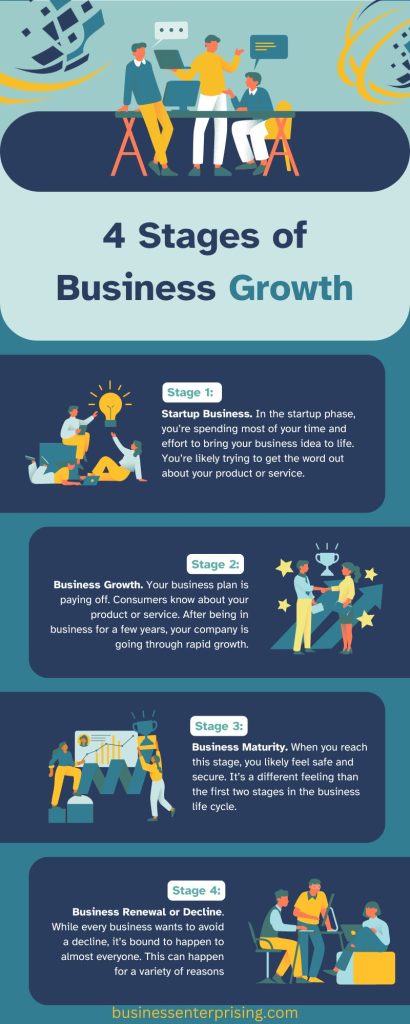
The Stages of Business Growth are critical for entrepreneurs who seek to understand how their business evolves over time. From the initial startup phase to maturity, each stage presents unique challenges and opportunities. Knowing these stages can help businesses navigate growth with more confidence and plan for future development. Business growth is rarely linear, but recognizing the distinct phases of a business’s lifecycle helps ensure that companies can scale efficiently while adapting to the demands of the market.
The Startup Stage
The first of the Stages of Business Growth is the startup phase, where a business idea takes shape and enters the market. Entrepreneurs focus on establishing their product or service, building customer bases, and securing initial capital. This stage involves high levels of uncertainty and risk as many businesses struggle to gain traction and prove their value. Cash flow is often a major challenge, with low revenue and high expenses related to launching the business.
Adaptability is essential during this phase. Entrepreneurs must be prepared to pivot their ideas based on market feedback and evolving customer needs. Defining the brand, understanding the target audience, and ensuring the product or service addresses a market gap are critical areas of focus. Businesses that navigate this stage successfully lay a solid foundation for future growth.
The Growth Stage
The growth stage marks a period of increased market presence, sales, and brand recognition. During this phase, businesses focus on scaling operations, hiring additional staff, and expanding their customer base. This is often considered one of the most exciting Stages of Business Growth, as companies experience tangible success and growing demand. However, the challenges are equally significant.
Managing rapid growth requires robust financial planning, strategic decision-making, and maintaining product quality. Businesses in the growth stage need to carefully manage resources to avoid overexpansion, which can lead to operational inefficiencies or cash flow problems. Customer satisfaction is key during this phase, as maintaining high-quality service ensures long-term loyalty. While growth is the goal, maintaining focus on core business values and managing the operational side is critical for ensuring sustainable success.
The Expansion Stage
After the growth stage, the expansion phase begins, where businesses seek new markets, product lines, or geographic regions. At this point, the company has established a strong presence in its original market and is now ready to broaden its reach. The expansion stage offers opportunities for diversification, but it introduces challenges like increased competition, regulatory hurdles, and the need for more complex operations.
During this phase, businesses should invest in market research to understand the demands and preferences of new markets they aim to target. Expanding too quickly without adequate research can lead to failure. It’s essential to balance innovation with maintaining the quality that initially made the company successful. This phase requires strategic investments and partnerships to facilitate growth while mitigating risks.
The Maturity Stage
The maturity stage is one of the most important Stages of Business Growth and signals that a business has established itself as a major player within its industry. Sales levels off, profitability stabilizes, and operations run efficiently. While this stage offers stability, it also presents challenges related to maintaining market relevance. The focus often shifts from rapid growth to innovation, process improvement, and optimizing internal efficiencies.
During this stage, companies must find ways to innovate and differentiate themselves from competitors. Stagnation can lead to a decline, so mature businesses often focus on product improvement or diversifying their offerings to stay relevant. Customer retention, brand loyalty, and entering new markets or industries can help businesses avoid complacency and continue evolving.
The Renewal or Decline Stage
Businesses at the maturity stage face two possible paths: renewal or decline. The renewal phase is one where a company reinvents itself through innovation, new leadership, or a strategic pivot. Companies that invest in research, embrace new technologies, or redefine their offerings can extend their lifecycle and stay competitive. This phase requires a forward-thinking mindset and the willingness to take calculated risks.
Businesses that fail to adapt during the maturity stage may enter a period of decline. Decline can result from market saturation, loss of competitive advantage, or failure to innovate. A declining business often faces falling sales and profitability, which may lead to downsizing or closure without timely corrective actions.
Understanding the Stages of Business Growth is crucial for entrepreneurs aiming to build sustainable, successful enterprises. From the uncertainty of the startup phase to the strategic decisions required in expansion, each stage offers unique opportunities and challenges. Successfully navigating these stages requires adaptability, strategic planning, and a deep understanding of market dynamics. By identifying the current growth stage of your business, you can make informed decisions that support continued success.

